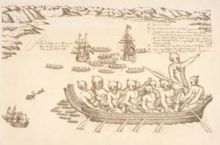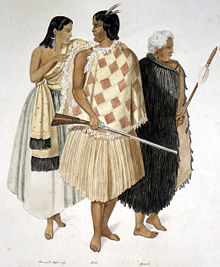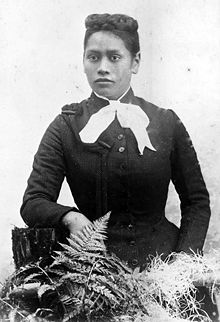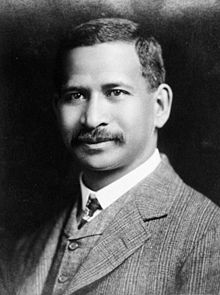Māori
2008/9 Schools Wikipedia Selection. Related subjects: Peoples
| Māori | ||||||||||||||||||
|---|---|---|---|---|---|---|---|---|---|---|---|---|---|---|---|---|---|---|
 |
||||||||||||||||||
| Hinepare of Ngāti Kahungunu, c.1890 | ||||||||||||||||||
| Total population | ||||||||||||||||||
|
approx. 725,000 |
||||||||||||||||||
| Regions with significant populations | ||||||||||||||||||
|
||||||||||||||||||
| Languages | ||||||||||||||||||
| Māori, English | ||||||||||||||||||
| Religion | ||||||||||||||||||
| Māori religion, Christianity | ||||||||||||||||||
| Related ethnic groups | ||||||||||||||||||
| other Polynesian peoples, Austronesian peoples |
The word Māori refers to the indigenous Polynesian people of New Zealand, and to their language.
Naming and self-naming
In the Māori language the word māori means "normal," "natural" or "ordinary." In legends and other oral traditions, the word distinguished ordinary mortal human beings from deities and spirits (wairua).
Early visitors from Europe to the islands of New Zealand generally referred to the inhabitants as "New Zealanders" or as "natives", but Māori became the term used by Māori to describe themselves in a pan-tribal sense. In 1947, the New Zealand government renamed the "Department of Native Affairs" as the "Department of Māori Affairs" to recognise this.
Māori people often use the term tangata whenua (literally, "people of the land") to describe themselves in a way that emphasises their relationship with a particular area of land — a tribe may be tangata whenua in one area, but not another. The term can also refer to Māori as a whole in relation to New Zealand (Aotearoa) as a whole.
Prior to 1974 ancestry determined the legal definition of "a Māori person". For example, bloodlines determined whether a person should enrol on the Māori or general (European) electoral roll; in 1947 the authorities determined that one man, 5/8ths Māori, had improperly voted in the European seat of Raglan. The Māori Affairs Amendment Act 1974 changed the definition to one of cultural self-identification, which technically means that a person with no Māori ancestry can enroll and vote in a Māori electorate. In matters involving money (for example scholarships or Waitangi Tribunal settlements), the authorities generally require some demonstration of ancestry or cultural connection, but no minimum "blood" requirement exists.
Origins
Archaeological and linguistic evidence (Sutton 1994) suggests that several waves of migration came from Eastern Polynesia to New Zealand between AD 800 and 1300. Māori oral history describes the arrival of ancestors from Hawaiki (a mythical homeland in tropical Polynesia) in large ocean-going canoes (waka: see Māori migration canoes). Migration accounts vary among tribes ( iwi), whose members may identify with several waka in their genealogies or whakapapa.
No credible evidence exists of human settlement in New Zealand prior to the Polynesian voyagers; on the other hand, compelling evidence from archaeology, linguistics, and physical anthropology indicates that the first settlers came from East Polynesia and became the Māori.
Development of Māori culture
The Eastern Polynesian ancestors of the Māori arrived in a forested land with abundant birdlife, including moa-species weighing from 20 to 250 Kg. Other species, also now extinct, included a swan, a goose, and the giant Haast's Eagle which preyed upon the moa. Marine mammals, in particular seals, thronged the coasts, with coastal colonies much further north than today. In the mid-19th century, people discovered large numbers of moa-bones alongside human tools, with some of the bones showing evidence of butchery and cooking. Early researchers, such as Julius von Haast, a geologist, incorrectly interpreted these remains as belonging to a prehistoric Paleolithic people; later researchers, notably Percy Smith, magnified such theories into an elaborate scenario with a series of sharply-defined cultural stages which had Māori arriving in a Great Fleet in 1350 AD and replacing the so-called moa-hunter culture with a "classical Māori" culture based on horticulture. Current anthropological theories, however, recognise no evidence for a pre-Māori people; the archaeological record indicates a gradual evolution in culture that varied in pace and extent according to local resources and conditions. Subsequent research dismisses the "Great Fleet" theory as largely a fabrication.
In the course of a few centuries, growing population-numbers led to competition for resources and an increase in warfare. The archaeological record reveals an increased frequency of fortified pā, although debate continues about the amount of conflict. Various systems arose which aimed to conserve resources; most of these, such as tapu and rāhui, used religious or supernatural threats to discourage people from taking species at particular seasons or from specified areas.
As Māori continued in geographic isolation, performing arts such as the haka developed from their Polynesian roots, as did carving and weaving. Regional dialects arose, with minor differences in vocabulary and the pronunciation of some words. However, the language retains close similarities to other Eastern Polynesian tongues, to the point where a Tahitian chief on Cook's first voyage in the region acted as an interpreter between Māori and the crew of the Endeavour.
Around 1500 AD, a group of Māori migrated east to Rekohu (the Chatham Islands), where, by adapting to the local climate and the availability of resources, they developed a culture known as Moriori — related to but distinct from Māori culture in Aotearoa. A notable feature of the Moriori culture, an emphasis on pacifism, proved disadvantageous when Māori warriors arrived in the 1830s aboard a chartered European ship.
Interactions with Europeans before 1840
European settlement of New Zealand occurred in relatively recent historical times. New Zealand historian Michael King in The Penguin History Of New Zealand describes the Māori as "the last major human community on earth untouched and unaffected by the wider world."
Early European explorers, including Abel Tasman (who arrived in 1642) and Captain James Cook (who first visited in 1769), recorded their impressions of Māori. From the 1780s, Māori encountered European and American sealers and whalers; some Māori crewed on the foreign ships. A trickle of escaped convicts from Australia and deserters from visiting ships, as well as early Christian missionaries, also exposed the indigenous New Zealand population to outside influences.
By 1830, estimates placed the number of Pākehā (Europeans) living among the Māori as high as 2,000. The newcomers had varying status-levels ranging from slaves to high-ranking advisors. Some remained little more than prisoners, while others abandoned European culture and identified as Māori. Many Māori valued such Pākehā as a means to the acquisition of European technology, particularly firearms. These Europeans "gone native" became known as Pākehā Māori. When Pomare led a war party against Titore in 1838, he had 132 Pākehā mercenaries among his warriors. Frederick Edward Maning, an early settler, wrote two colourful accounts of life in these times, which have become classics of New Zealand literature: Old New Zealand and History of the War in the North of New Zealand against the Chief Heke.
During the period from 1805 to 1840 the acquisition of muskets by tribes in close contact with European visitors upset the balance of power among Māori tribes, leading to a period of bloody inter-tribal warfare, known as the Musket Wars, which resulted in the decimation of several tribes and the driving of others from their traditional territory. European diseases such as influenza and measles also killed an unknown number of Māori: estimates vary between ten and fifty per cent.
1840 to 1890: The marginalisation of Māori
With increasing Christian missionary activity, growing European settlement in the 1830s and the perceived lawlessness of Europeans in New Zealand, the British Crown, as a world power, came under pressure to intervene. Ultimately Britain sent William Hobson with instructions to take possession of New Zealand. Before he arrived, Queen Victoria annexed New Zealand by royal proclamation in January 1840. On arrival in February 1840, Hobson negotiated the Treaty of Waitangi with northern chiefs. Other Māori chiefs subsequently signed this treaty. In the end, only 500 chiefs out of the 1500 sub-tribes of New Zealand signed the Treaty, and some influential chiefs, such as Te Wherowhero in Waikato, and Te Kani-a-Takirau from the east coast of the North Island, refused to sign. The Treaty made the Māori British subjects in return for a guarantee of property-rights and tribal autonomy.
Dispute continues over whether the Treaty of Waitangi ceded Māori sovereignty. Māori chiefs signed a Māori-language version of the Treaty that did not accurately reflect the English-language version. It appears unlikely that the Māori-language version of the treaty ceded sovereignty; and the Crown and the missionaries probably did not fully explain the meaning of the English-language version.
Māori formed substantial businesses, supplying food and other products for domestic and overseas markets.
Among the first Europeans who both learnt the Māori language and also recorded Māori mythology, George Grey, Governor of New Zealand from 1845 to 1855 and from 1861 to 1868, stands out.
In the 1860s, disputes over questionable land purchases and the attempts of Māori in the Waikato to establish what some saw as a rival to the British system of royalty led to the New Zealand land wars. Although these resulted in relatively few deaths, the colonial government confiscated large tracts of tribal land as punishment for what they called rebellion (although the Crown had initiated the military action against its own citizens), in some cases taking land even from tribes which had taken no part in the war. Some tribes actively fought against the Crown, while others (known as kupapa) fought in support of the Crown. A passive resistance movement developed at the settlement of Parihaka in Taranaki, but Crown troops dispersed its participants in 1881.
The Native Land Acts of 1862 and 1865 set up the Native Land Court, which had the purpose of breaking down communal ownership and facilitating the alienation of land. As a result, between 1840 and 1890 Māori lost 95 per cent of their land (63,000,000a of 66,000,000 -55,000,000a in 1890).
With the loss of much of their land, Māori went into a period of numerical and cultural decline, and by the late 19th century most people believed that the Māori population would cease to exist as a separate race and become assimilated into the European population.
In 1840, New Zealand had a Māori population of about 100,000 and only about 2,000 Europeans. By the end of the 19th century, the Māori population had declined to 42,113 (according to the 1896 census) and Europeans numbered more than 700,000.
Revival
The decline of the Māori population did not continue; instead levels recovered. Despite a substantial level of intermarriage between the Māori and European populations, many Māori retained their cultural identity. A number of discourses developed as to the meaning of "Māori" and to who counted as Māori or not. (Māori do not form a monolithic bloc, and no one political or tribal authority can speak on behalf of all Maori.)
From the late nineteenth century, a number of successful Māori politicians emerged. These men, such as James Carroll, Apirana Ngata, Te Rangi Hiroa and Maui Pomare showed skill in the arts of Pākehā politics; at one point Carroll became Acting Prime Minister. The group, known as the Young Māori Party aimed to revitalise their people after the devastation of the previous century. For them this involved assimilation - Māori adopting European ways of life such as Western medicine and education. However Ngata in particular also wished to preserve traditional Māori culture, especially the arts. Ngata acted as a major force behind the revival of arts such as kapa haka and carving. He also enacted a programme of land development which helped many iwi retain and develop their land.
The New Zealand government decided to exempt Māori from the conscription that applied to other citizens in World War II, but nonetheless Māori volunteered in large numbers, forming the 28th or Māori Battalion, which performed creditably, notably in Crete, North Africa, and Italy. Altogether 17,000 Māori took part in the war.
Since the 1960s, Māoridom has undergone a cultural revival strongly connected with a protest-movement. Government recognition of the growing political power of Māori combined with political activism have led to a limited redress for unjust confiscation of land and for the violation of other property rights. The State set up the Waitangi Tribunal, a body with the powers of a Commission of Enquiry, to investigate and make recommendations on such issues. Significantly, because of the manner in which the Government empowered it, the Tribunal cannot make binding rulings. However, as a result of the redress paid to many iwi (tribes), Māori now have significant interests in the fishing and forestry industries. Tensions remain however, with complaints from Māori that the settlements occur at a level of between 1 and 2.5 cents on the dollar of the value of the confiscated lands. The Government need not accept the findings of the Waitangi Tribunal, and has rejected some of them, with a most recent and widely-debated example in the New Zealand foreshore and seabed controversy.
The urbanisation of Māori proceeded apace in the second half of the 20th century. A majority of Māori people now live in cities and towns, and many have become estranged from tribal roots and customs.
Once Were Warriors, a 1994 film adapted from a 1990 novel of the same name by Alan Duff, brought the plight of some urban Māori to a wide audience. It became the highest grossing film in New Zealand that year and received international acclaim, winning several international film-prizes. While some Māori feared that viewers would consider the violent male characters an accurate portrayal of Māori men, most film-critics praised it as exposing, on an international stage, the raw side of domestic violence. Some Māori opinion, particularly feminist, welcomed the debate on domestic violence that the film enabled.
In many areas of New Zealand, the Māori language lost its role as a living community language (used by significant numbers of people) in the post-war years. In tandem with calls for sovereignty and the righting of social injustices from the 1970s onwards, many New Zealand schools now teach Māori culture and language, and pre-school kohanga reo (literally: "language nests") have started which teach tamariki (young children) exclusively in Māori. These now extend right through secondary schools (kura tuarua). In 2004 Māori Television, a government-funded TV station committed to broadcasting primarily in te reo, began broadcasting. Māori language, enjoys the equivalent status de jure as English in government and law, although the language continues to be marginalised in mainstream use. At the time of the 2006 Census, Māori figured as the second most widely-spoken language in New Zealand after English, with 4% of New Zealanders able to speak Māori to at least a conversational level.
As of 2008, Māori politicians have seven designated Māori seats in the Parliament of New Zealand (and they may and do stand in and win the General seats), and consideration of and consultation with Māori have become routine requirements for many New Zealand councils and government organisations. Debate occurs frequently as to the relevancy and legitimacy of the Māori electoral roll, although currently neither of the two major political parties intend to abolish it.
Despite significant social and economic advances during the twentieth century, Māori tend to cluster in the lower percentiles in most health and education statistics and in labour-force participation, as well as featuring disproportionately highly in criminal and imprisonment statistics. As with many indigenous cultures from around the world, Māori suffer both institutional and direct racism. For example, in December 2006, vandals sprayed racist graffiti on ancient Māori rock-art at the Raincliff Historic Reserve in South Canterbury.
Intellectual property
In 2001 a dispute concerning the popular LEGO toy line " Bionicle" arose between Danish toymaker Lego Group and several Māori tribal groups (fronted by lawyer Maui Solomon) along with several members of an on-line discussion-forum ( Aotearoa Cafe). The Bionicle product-line allegedly used many words appropriated from Māori language, imagery and folklore. The dispute ended in an amicable settlement. Initially the Lego Group refused to withdraw the product, saying it had drawn the names from many cultures, but later agreed that it had taken the names from Māori and agreed to change certain names or spellings to help set the toy-line apart from the Māori legends. This, however, did not prevent the many Bionicle users from continuing to use the disputed words, resulting in the popular Bionicle website BZPower coming under a denial-of-service attack for four days from an attacker using the name Kotiate.
Commerce
The New Zealand Law Commission has started its own project to develop a legal framework for Māori who want to manage communal resources and responsibilities. The voluntary system proposes an alternative to existing companies, incorporations, and trusts in which tribes and hapu and other groupings can interact with the legal system. The foreshadowed legislation, under the proposed name of the "Waka Umanga (Māori Corporations) Act", would provide a model adaptable to suit the needs of individual iwi. It seems likely that the current Government coalition will not support the Bill in its un-amended form and if the final Act should pass into law, it will presumably depart significantly less radically from the current legal personalities afforded by British/New Zealand law.
Religion
Māori "tend to be followers of Presbyterianism, the Church of Jesus Christ of Latter-day Saints (Mormons), or Maori Christian groups such as Ratana and Ringatu",, but with Catholic, Anglican and Methodist groupings also prominent. Maori Christian faiths syncretize Christian tenets with precolonial Maori beliefs.
Today Islam figures as the fastest-growing religion amongst the Māori community, with numbers increasing from 99 to 708 in the 10 years to 2001. (See Islam in New Zealand).
Modern socio-economic issues
Māori class as poorer on average than the rest of the population of New Zealand, and run greater risks of many negative economic and social outcomes. Over 50% of Māori live in areas classed in the three highest deprivation deciles, compared with 24% of the rest of the population. Although Māori make up only 14% of the population, they make up almost 50% of the total prison population. Māori have higher unemployment-rates than other cultures resident in New Zealand. Māori have higher numbers of suicides than non-Māori. "Only 47% of Māori school-leavers finish school with qualifications higher than NCEA Level One; compared to a massive 74% European; 87% Asian." (Most pupils attain NCEA Level One, New Zealand's main secondary-school qualification, after 11 years of schooling.) Māori also suffer more health problems, including alcohol and drug-related problems, per head of population than any other culture living in New Zealand.





